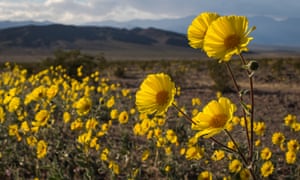Heavy autumn rains have transformed the California park from salt flats and sand dunes to a colorful floral landscape not seen to this extent since 2005

Parts of Death Valley, the driest place in North America, have exploded in a riot of color with a rare “superbloom” of millions of wildflowers.
The flowers have blanketed the desert valley to an extent not seen since 2005. The bloom started in the southern part of the Californian wilderness and is now moving north, displaying colorful species including the golden evening primrose (Camissonia brevipes), notchleaf phacelia (Phacelia crenulata) and fields of desert gold (Geraea canescens).
The unusual spectacle, unofficially dubbed a superbloom, has been triggered by a series of storms in October that brought heavy rainfall to parts of the park, including a burst of 3in of rain in just five hours. Death Valley normally averages just 2in of rain a year.
This rainfall, which the National Park Service has attributed to El Niño conditions that have soaked parts of California, has transformed a landscape that has a beauty usually considered a little more stark, featuring salt flats, sand dunes and scrub.
“The hills and alluvial fans that normally have just rocks and gravel are transformed by huge swaths of yellow, white, pink and purple,” said Alan Van Valkenburg, a Death Valley national park ranger. “At first glance you are blown away by the sheer numbers of flowers, then on closer inspection the diversity of species will draw you in.”
Death Valley is known for its blistering heat – the hottest day ever reliably recorded in the world was at the valley’s Furnace Creek in July 1913, when it reached 134F (56.7C). For five months of the year, the heat is so intense that the landscape appears to shimmer.
The valley also contains the lowest point in North America, as well as snow-covered mountains. Despite the harsh conditions, more than 1,000 species of plants are found in Death Valley, as well as a selection of bats, squirrels, coyotes and desert bighorn sheep.
The National Park Service that while the “intense beauty” of the flowers will result in an increase in tourism to Death Valley, visitors should be careful to not pick or remove wildflowers, as this is illegal.

